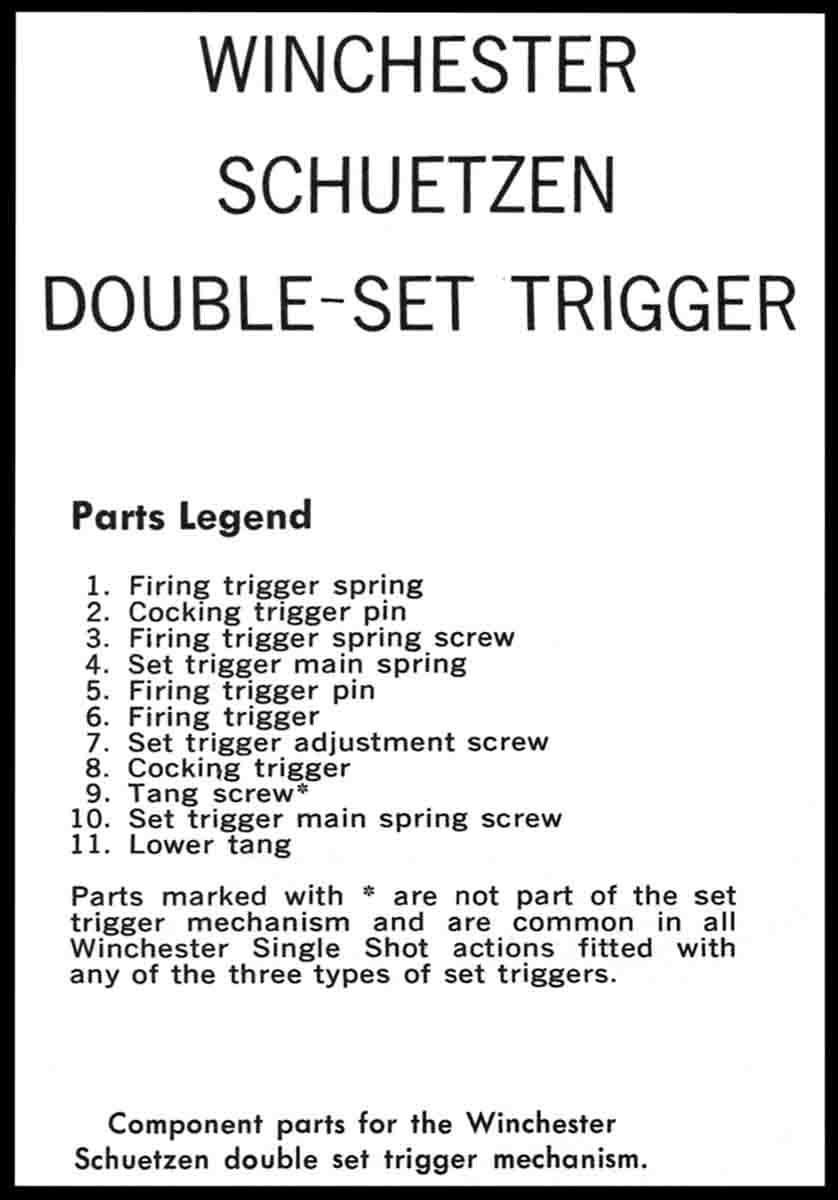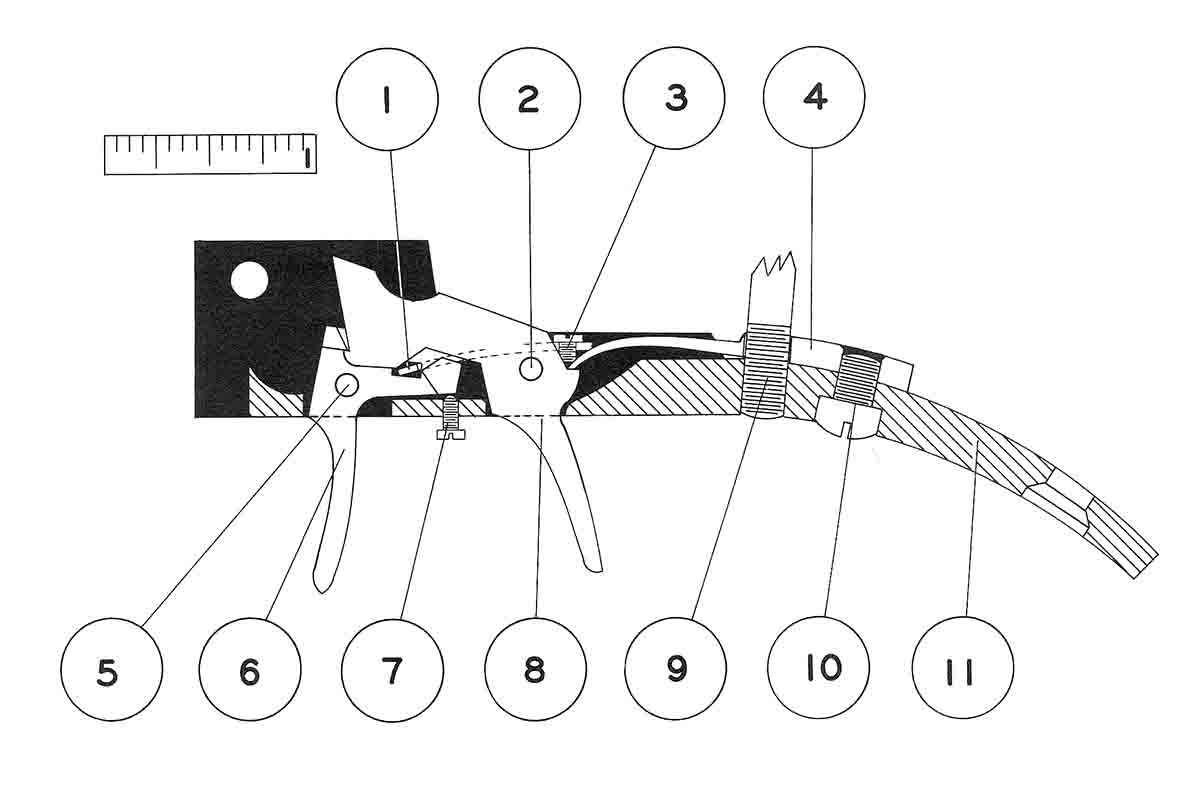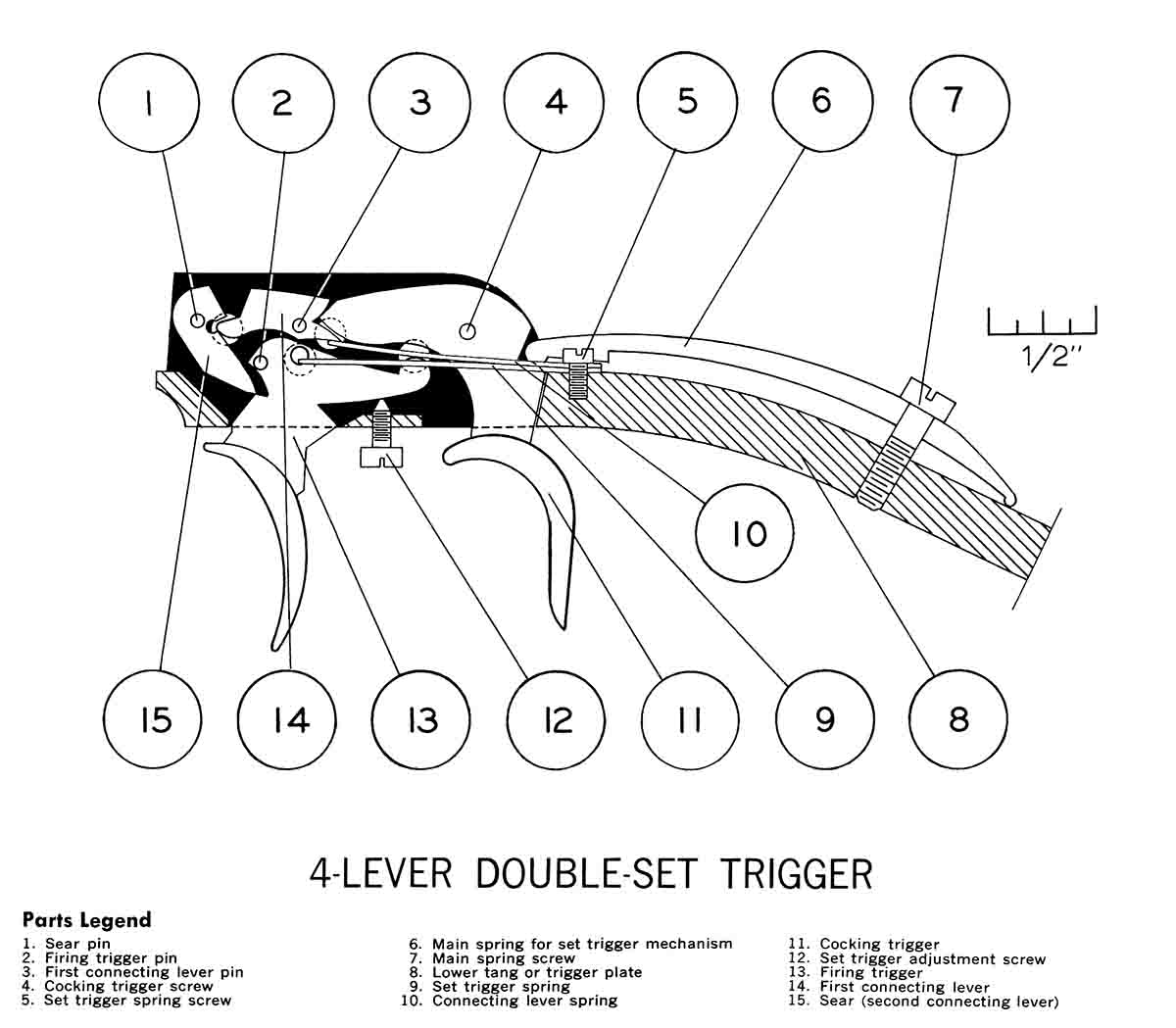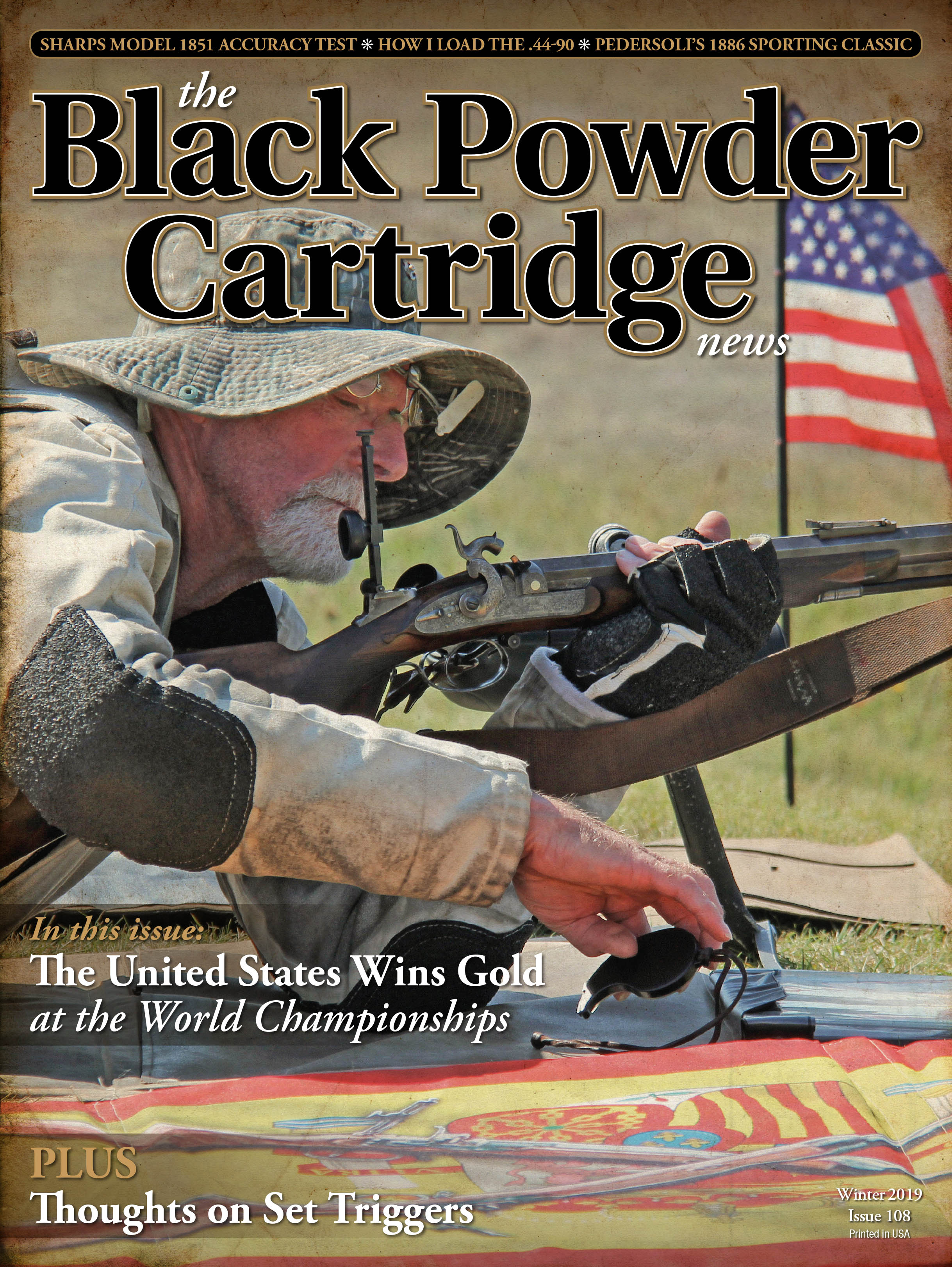Thoughts on Set Triggers
feature By: Steve Garbe | November, 19
Most of us in the single-shot world have rifles that utilize set triggers. However, I feel there are many misconceptions concerning set triggers even among those riflemen who have used them most of their life. Used in the correct fashion, set triggers can definitely help your shooting. Used incorrectly, they can promote bad habits and really create life-long mental shooting problems.

First off, what are “set triggers”? Set triggers are a firing mechanism that releases a rifle’s sear while allowing for a light trigger release without undue wear to the rifle’s sear surfaces. Set triggers make it relatively easy to adjust a trigger pull up or down, depending upon the rifleman’s preference. Set triggers also make possible a lighter trigger release, which in turn, means lessened disturbance to the rifle when the trigger releases.
Set triggers come in many forms. There are single and double-lever set triggers, single-set triggers, close-coupled set triggers as well as four-lever (or more) set triggers.
Single-lever set triggers must be “set” and then tripped to disengage the rifle’s sear. Double-lever set triggers allow the forward trigger to disengage the sear by itself, without being “set”, generally providing a heavier trigger pull. A single-set trigger is obviously one trigger that has to be “set” by pushing forward, then released by being pulled backward. Close-coupled double-set triggers have a rear trigger that sets the mechanism by being pushed forward, then the front trigger is pulled rearward to release. Winchester manufactured many of the close-coupled double-set triggers that we see on vintage rifles, although there are a few gunsmiths today that build them. Many vintage German and Swiss single-shot rifles were fit with complicated four-lever set triggers that gave the advantage of incredibly light and uniform trigger releases. These triggers internally resemble a watch with all their closely fit parts and are masterpieces of workmanship.
In shooter’s conversations one will hear about set triggers that are adjusted so lightly that one can simply “think” the trigger off. Some competitors will describe how they have their triggers adjusted to surprise them when they fire, so that they avoid flinching or grabbing the trigger. These are common misconceptions about the true benefits of a set trigger, and can actually be detrimental to developing good shooting habits. Having a set trigger too light is unsafe and actually encourages a reluctance to break the shot. As far as having a trigger that “surprises” you when it breaks, one only needs to use a trigger several times and your mind registers the amount it takes to break the shot. There is no “surprise” involved after a few fired shots.
I have frequently been amazed when examining other shooter’s rifles to find that the set triggers are seriously out of adjustment. Typically, the small set-screw found between the two triggers will adjust the engagement, and therefore the pull required to release the front trigger. A good rule of thumb is to set the rear trigger (with an unloaded and uncocked rifle) and then turn the adjustment screw in until the front trigger trips. Back the adjustment screw out one-half turn to provide a generally creep-free set trigger break. This adjustment screw can work in or out with repeated operation, so sometimes a small drop of stock finish will stop it going out of adjustment. You don’t want to use anything that sets up hard on the threads, as this finely threaded adjustment screw is easy to strip. Make sure that there is no creep to the set trigger release; a trigger with creep is almost impossible to do good work with.

The two greatest benefits to a good set trigger in my opinion are, firstly, minimal disturbance to the rifle when releasing the trigger and, secondly, the speed at which the shot can be fired when the proper sight picture is seen by the eye. Even a perfectly crisp two-pound trigger, which is widely regarded as a somewhat “light” trigger, still requires that two pounds of pressure be applied before the trigger will fire the rifle. Put your rifle on a bench rest with a 20X scope and dry fire, taking note of how much those crosshairs move when the trigger is released. If your trigger has significant over-travel it will be quite amazing to see how far those crosshairs will move. Next try it with a good set trigger and see how much less movement there is simply because of the less pressure it takes to fire the rifle. We seldom see these things because, when firing live ammunition, the recoil of the rifle covers up the movement. Add to this trigger-induced movement the force and time of the hammer-fall (especially in the case of a side-hammer rifle) and you can see that there is much going on that is detrimental to keeping those sights on the target before the bullet clears the muzzle. Given a perfect sight picture, the less we do to disrupt the hold, the better off we are.
In all shooting, but especially in offhand shooting, breaking the shot when the sights are on target is essential. Given that no human being can hold a rifle perfectly still from the offhand position, a good set trigger allows for a much faster response to a correct sight picture. Any time spent pulling the trigger while the sights are on target simply means that the sights will be drifting away from center. The accomplished offhand shot does not squeeze a set trigger while attempting to keep the sights on target, but breaks it without hesitation when the sights are right. Of course, it goes without saying that one has mastered a good follow-through to compliment this quick breaking of the trigger. A quick break can easily turn into a “grab” and one must psychologically be on the alert for this.
It is important that one practice dry-firing with a set trigger in order to keep the trigger finger educated to the exact amount of pressure required to release the trigger. In this way, the rifleman can time the swing of his sights to correspond with the trigger release. At some point in practice, you will notice that your subconscious will take over the release of the trigger. This is what is really desired by the proficient offhand marksman, as the subconscious mind is much quicker to release the shot. We see some examples of subconscious control when driving a car, typing on a keyboard or riding a bike. If one stops to think about what they are doing with their conscious mind it is impossible to achieve any measure of success. If you are suddenly confronted with a stop sign when driving, your foot automatically goes to the brake, just as your fingers know where the keys are on a keyboard or your sense of balance is when riding a bike. This is the state we want for the best of trigger control with or without set triggers, but set triggers actually make this an easier and quicker operation to coordinate with a correct sight picture.

Another tip for using set triggers, especially when it is cold, is to use the middle finger to actually “set” the trigger, using the trigger finger for only pulling the front trigger. Pulling a somewhat stiff rear trigger with your trigger finger will desensitize the finger to a light touch as well as making it stiff and cold much faster. Also, always get in the habit of setting your trigger when the rifle is pointed at the target and not before. It is much too easy to have an accidental discharge if the rifle is moved to the shoulder when the triggers are set and the hammer cocked.
If you are using set triggers that have generous clearances on the trigger pivot pins (as most factory triggers do) be careful to always set the rear trigger in the same way, i.e. pressing straight back or pulling slightly to one side or the other. Changing how you set the rear trigger will change slightly the amount that the rear trigger engages the front trigger, resulting in a different trigger pull.
Some riflemen, especially those who struggle with proper follow-through, are better served using a crisp, clean single trigger rather than a light set trigger. Relaxing the hold or jumping at the trigger are easy habits to acquire if one is not disciplined in a clean trigger break and follow-through. Better scores will result if the rifleman works at a good follow-through with a clean trigger break rather than trying to “grab” a shot with a light set trigger. If you are just starting to use set triggers, it is much better to have your triggers set on the heavy side rather than too light. As your shooting progresses and you cultivate a good hold and follow through, you can lighten the triggers to provide a faster break.
Used and adjusted correctly, a good set trigger can add to your score. It will not cover up poor shooting habits or fool your holding muscles into a good follow through. There are no shortcuts to good shooting, only a good mental mindset and plenty of practice.


